The Statue of Liberty is an enduring symbol of freedom that has stood welcoming people to New York Harbor since 1886. She is an iconic symbol of America, and one of the very first things immigrants arriving to Ellis Island saw. A universal symbol of freedom recognized around the world, the statue of Lady Liberty has come to represent the United States itself. With that much symbolism and as a monument who has witnessed America becoming what it is today, no visit to NYC is truly complete without visiting the Statue of Liberty and Ellis Island.
And yet, I had never been to visit the Statue of Liberty and Ellis Island despite more than a dozen trips to New York City over the past nearly two decades. It was time to change that.
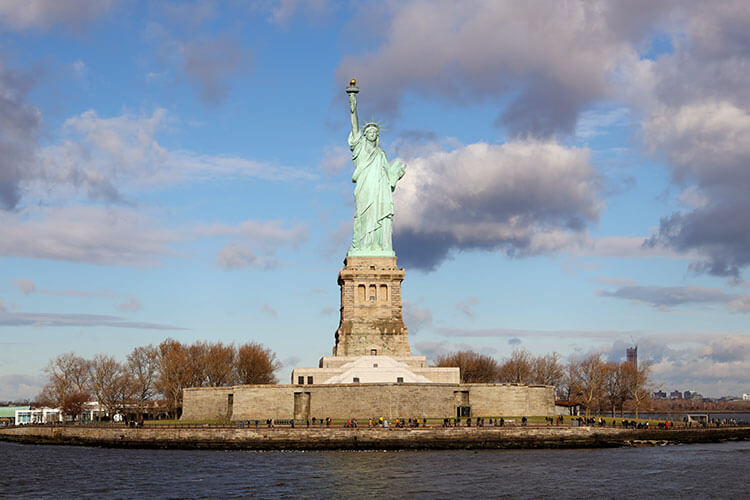
Visiting the Statue of Liberty and Ellis Island
“Get your cameras ready!”
Our guide for our Walks Early Access Statue of Liberty and Ellis Island tour, Rachel, had made sure we were nearly first to board the ferry. She also directed us to grab some seats at the few tables available on the left side as you board the ferry.
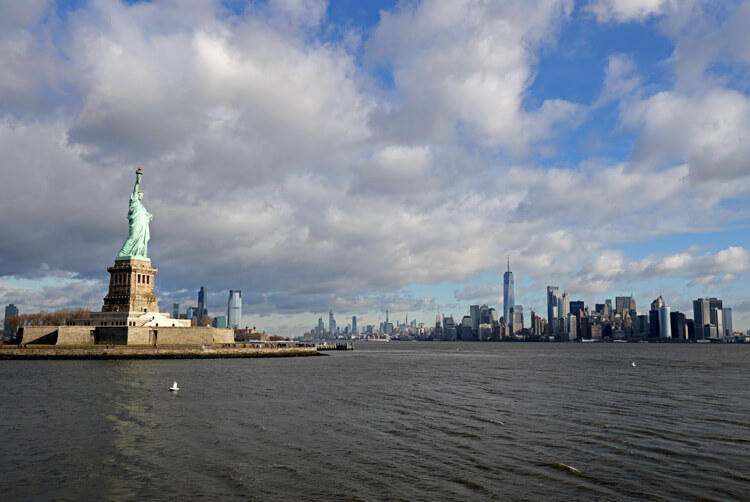
Rachel has been visiting the Statue of Liberty and Ellis Island and guiding this tour for over four years, and she clearly knows her stuff. Just as she told us to get our cameras ready, the ferry swooped out around the side of Liberty Island to give us the ultimate view of Lady Liberty holding her torch high with the skyscrapers of Lower Manhattan rising up behind her.
When European immigrants arrived in New York harbor during the years that they filtered through Ellis Island, they would have seen Lady Liberty just as we did today…only the skyline of Lower Manhattan would have looked quite a bit different back then. The Statue of Liberty was the tallest structure in NYC in 1886, standing at the equivalent of 22-story tall building.
After the ferry docked at Liberty Island, Rachel lead our small group up to the small museum inside the Statue of Liberty pedestal. Many of the objects here have now been moved over to the brand new state-of-the-art Statue of Liberty Museum that opened in late spring of 2019. But it’s still worth a look for a lot of interesting information and Statue of Liberty facts.
Most visitors with pedestal access tickets make a dash for the stairs (or elevator) up. Rachel knew better and shared her wealth of Statue of Liberty fun facts before giving our small group free time to climb up to the pedestal at our own pace.
There are a total of 215 steps between the lobby and the top of the Statue of Liberty pedestal. There is an elevator for those who need it, but you should be aware that there are still a few steps to climb between the lobby and the elevator access.
Once you reach the top of the Statue of Liberty pedestal, don’t immediately rush outside. You can peer up inside the Statue of Liberty from an area just at the top of the stairs, and there is an official there to point you to the exact spot you need to stand.
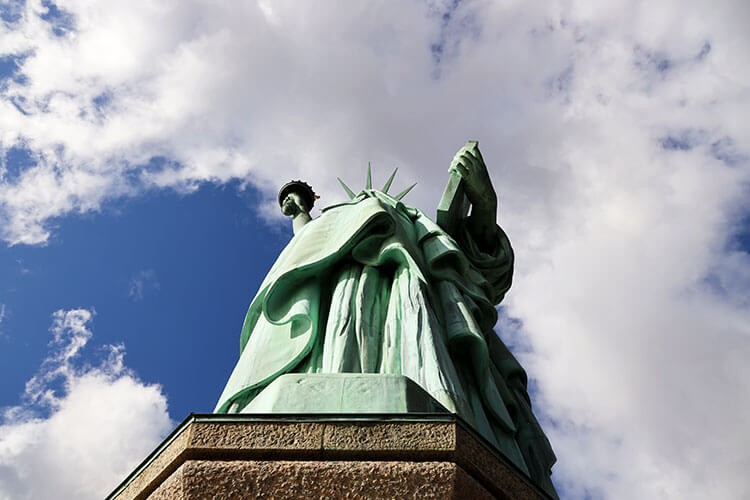
Once outside on the pedestal, Lady Liberty towers over the top of you. You can’t see much detail as it’s like craning your neck up at one of NYC’s skyscrapers from the entrance. But without scoring the hard-to-get Crown Access tickets, this is as close to Lady Liberty as you can possibly get.
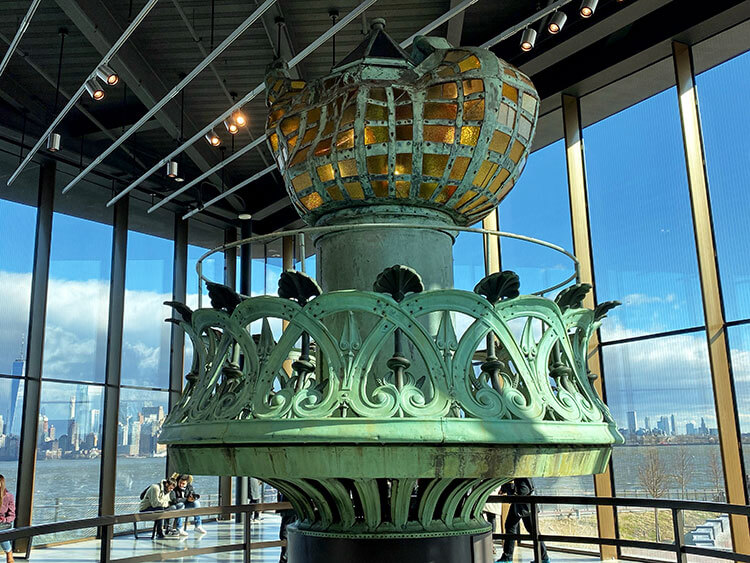
While the original Statue of Liberty still stands on the pedestal where she was placed, Lady Liberty now holds her second torch. The original torch had to be replaced in 1984 with a new copper torch, and it was covered in 24k gold leaf during the 1986 restoration. Visitors can get up close to the original torch located inside the new Statue of Liberty Museum, which there is some free time on the tour to go over and explore.
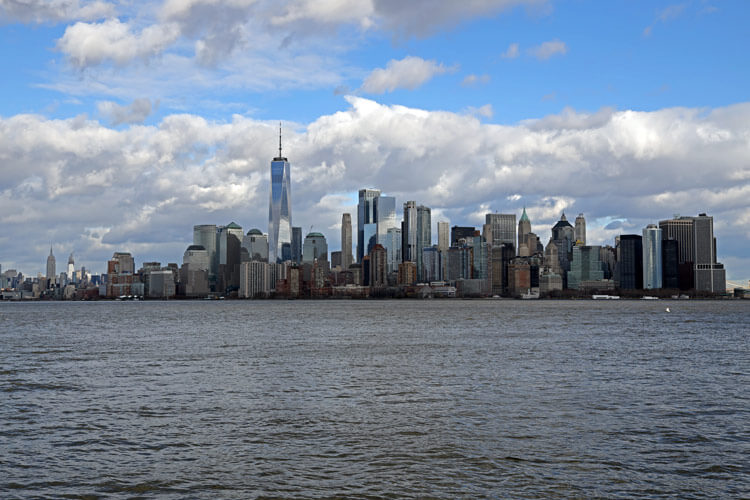
Of course, the views of Lower Manhattan are something to behold from Liberty Island. Be sure you leave enough time to take some photos of the new World Trade Center before leaving Liberty Island.
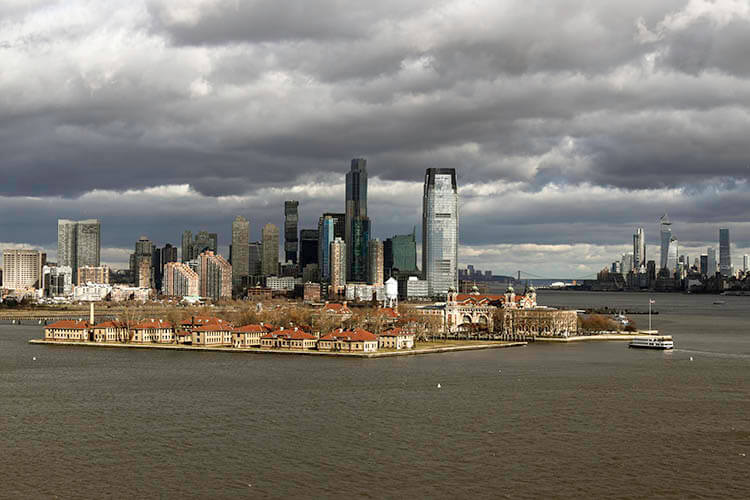
Reconvening at our agreed upon meeting time, Rachel ushered our small group back on to the ferry to cross over to Ellis Island. Once on Ellis Island, Rachel found a quiet spot where we could all sit down and hear about Ellis Island history.
With photographs, Rachel shared the stories of several Ellis Island immigrants. Through the photographs, adverts and propaganda posters shared on the Walks tour, we learned so many Ellis Island facts.
It’s here that the Walks Ellis Island visit ends, and you’re free to head back to Battery Park with the guide or stay to explore further on your own. The Ellis Island ferry ticket is good for any return and departs back to Battery Park regularly.
It’s definitely worth sticking around. The Ellis Island Museum is considered to be one of the best in New York City, and the interactive displays, photos and videos provide an even deeper look into Ellis Island immigration.
One question that came up was can you look through immigration log books like in the movie Hitch. Rachel told us that the famous scene is totally fictional. All the records from Ellis Island, and the Port of New York passenger records going back to 1820, have long since been digitized.
If you know the name of a relative that passed through Ellis Island, it’s very easy to do a free online Ellis Island record search in the passenger search maintained by the American Family Immigration History Center located on Ellis Island.
Not included in the Walks tour is the Ellis Island Hard Hat Tour. You can either book the Hard Hat Tour in advance or on the spot at the concierge desk. We didn’t have time for the 90-minute Hard Hat Tour of Ellis Island since we were continuing our afternoon with a timed priority access One World Observatory ticket, but it was something we wish we’d known about in advance to better plan our day.
One thing you learn on the Ellis Island tour is just how many immigrants received medical attention at the Ellis Island South Side Hospital Complex. Approximately 1 in every 10 of the over 12 million immigrants that entered the United States through Ellis Island were treated in the hospital complex.
The 29-building complex, which was the largest US Public Health Service Institution in the United States in its day, was mostly abandoned and shuttered to the public for over 60 years. The Ellis Island hospital tour, or Hard Hat Tour as it is officially known, is a look into the eerily abandoned hospital where so many immigrants spent their first days, weeks or even months in America.
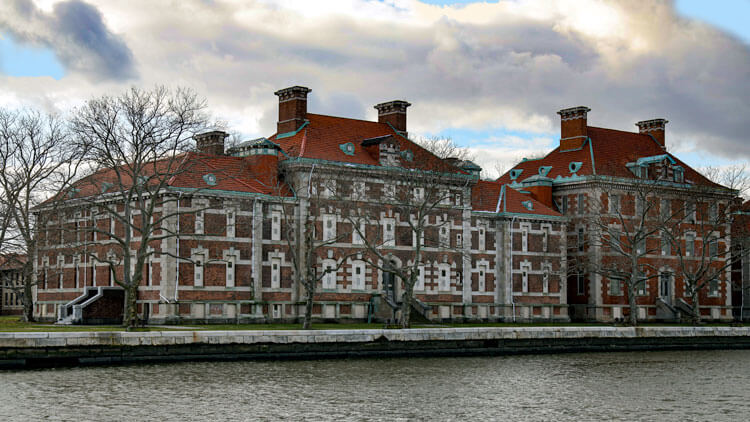
The hospital has never been restored, so you see it as it was left with the walls crumbling and abandoned medical equipment. There’s also the “Unframed –Ellis Island” art exhibition by renowned artist JR of life-size historical photographs of Ellis Island immigrants on the walls of the abandoned hospital.
If you don’t have time for the Hard Hat Tour like us, or it’s just not of interest, Rachel did point out one door our group could look through the windows of for a glimpse of the abandoned hospital.

Statue of Liberty Facts and History
While the Statue of Liberty is one of the world’s most recognizable landmarks and a symbol of the United States, it was conceived, sculpted and assembled by the French as a gift. The French historian Edouard de Laboulaye came up with the idea to create the Statue of Liberty around the time of the end of the Civil War in 1865 to congratulate the United States on building a successful democracy. de Laboulaye hoped that the Statue of Liberty would also inspire the French to break free of the represive Napoleon III and establish their own democracy.
The former Statue of Liberty Museum located inside the pedestal and the brand new Statue of Liberty Museum located on Liberty Island walk through the fascinating history of the Statue of Liberty. It’s definitely worth spending some time to learn about the statue that has become the symbol of our country.
The project was proposed and in 1875 the Franco-American Union was born. With de Laboulaye heading the Union as president, it was agreed that the French would build and assemble the Statue of Liberty as a gift to the US, while the Americans would conceive and build a pedestal for her to stand upon. The entire project would serve as a reminder of the enduring friendship between France and the United States of America.
Over the next seven years from 1885 – 1872, the Franco-American Union raised money for the construction of the Statue of Liberty through a series of fundraisers and lotteries. French citizens contributed some $250,000 and were quite enthusiastic about the statue; the French government did not contribute any funds.
The French sculptor Frederic Auguste Bartholdi, known for his large-scale sculptures, won the commission. It was Bartholdi who hammered out the copper sheets of metal for the statue. And another Frenchman you likely know, Gustave Eiffel, worked along with Bartholdi to design the steel framework for statue.
Across the pond, the Americans were equally as busy fundraising in order to raise the funds to build the pedestal that the Statue of Liberty would stand upon. Money was raised through various contests and exhibitions. The completed torch stood on display in Philadelphia to help get Americans enthusiastic about donating, much like the original torch is now displayed in the Statue of Liberty Museum.
It was with the help of Joseph Pulitzer, the man for whom the Pulitzer Prize is named after he left money in his will to start the now annual award, that the final funds necessary to build the platform were earned. He started what is recognized as one of the earliest crowdfunding campaigns in the US in his newspaper, New York World.
In only five months time New York World raised $101,091 from over 160,000 donors. Everyone from children to businessmen gave donations to cover the remaining $100,000 necessary to complete the pedestal and more than 75% of the donations were $1 or less. Pulitzer was truly a genius publisher and marketer far ahead of his time.
Batholdi completed the Statue of Liberty in 1885, disassembled her, and packed her in to more than 200 crates. Much like the many immigrants that would arrive to the United States via ship in New York Harbor from 1882, Lady Liberty arrived on the French frigate ship Isere. It took French workers four months to unpack and reassemble Liberty on her newly American-built pedestal.
Then President Grover Cleveland dedicated the Statue of Liberty on October 28, 1886 with the enthusiastic applause of a crowd of thousands of spectators.
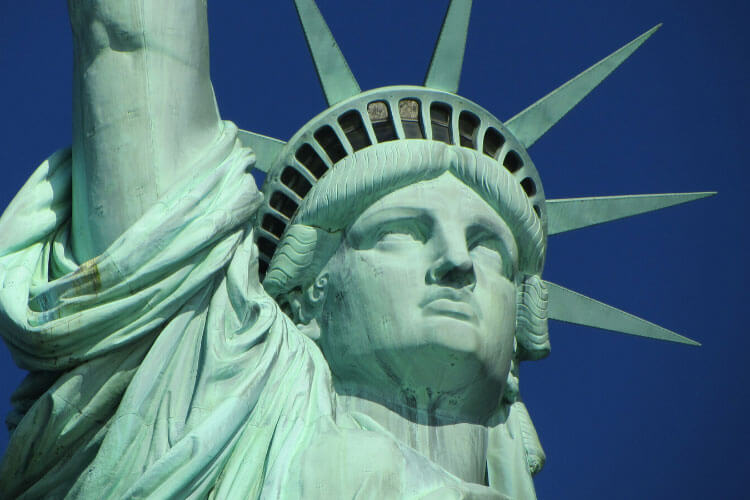
Here’s just a few fun facts you can learn when you go on the best Statue of Liberty tour:
- The actual name of the Statue of Liberty is Liberty Enlightening the World.
- The Statue of Liberty, including the pedestal, stands 305 feet 6 inches tall.
- Made of copper, the Statue of Liberty is only 3/32 of an inch thick (less than the thickness of two pennies)!
- The Statue of Liberty can and does move. She typically sways up to 3 inches and the torch sways up to 5 inches in 50MPH winds, but Liberty swayed much more than that during Hurricane Sandy.
- There are seven rays on Liberty’s crown, representing the seven continents.
- The tablet Liberty holds in her left hand is inscribed JULY IV MDCCLXXVI (July 4, 1776), representing the date the Declaration of Independence was signed and the birth of the United States of America.
- Liberty’s face very closely resembles two people: Bartholdi’s mother, Charlotte and George Washington
- You can’t actually see Liberty’s feet unless you take a helicopter tour, but she stands among broken chains, representing the broken shackles of broken shackles of oppression and tyranny.
- The Statue of Liberty is technically a lighthouse! The Statue of Liberty operated as a lighthouse between 1886 – 1901 under the control of the Lighthouse Board. But she was retired as a lighthouse because the light in the torch was barely visible from Lower Manhattan.
- It only took Liberty 30 years to turn green. The Statue of Liberty before oxidation was the color of a shiny new penny. Her green color, which was completely turned green by 1920, is called “patina”.
- The Statue of Liberty base is actually a fort called Fort Wood. It was constructed in 1807 and is shaped like an 11-point star.
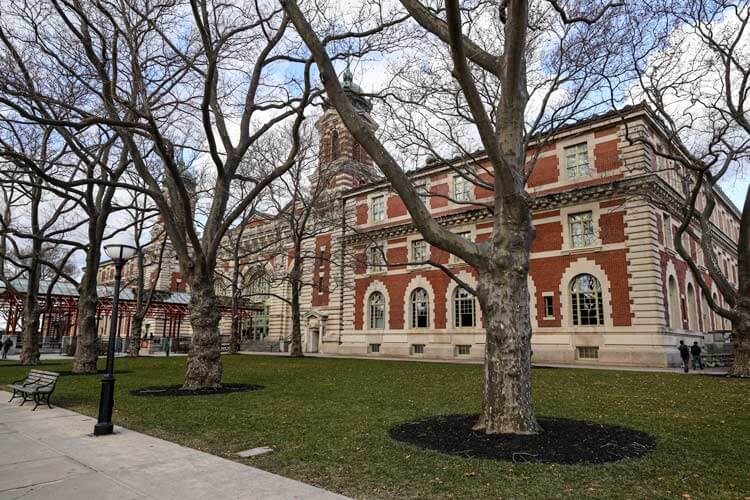
Ellis Island Facts and History
Ellis Island has a history that goes back long before it was an immigration station. Originally a natural tidal flat, the Indian tribes called it “Kioshk,” meaning gull island. It was a paradise for oyster beds and also once was called Oyster Island during the Dutch and English colonial periods. It was even privately owned in the 1700s.
An immigrant from Wales named Samuel Ellis bought the island in the 1770s and built a pub on it. Fisherman and even pirates swilled their drinks there until Ellis’ heirs sold the island to New York State. In 1808 the island was sold to the federal government.
It was the Federal government that built a fort on Ellis Island and made it part of the New York Harbor defense system. The once 4-acre sized tidal flat grew to 27.5 acres in size thanks to construction and landfill.
As for immigration, prior to 1890 it was all individual states that regulated the immigration to the United States of America. Castle Clinton in Battery Park, which is pointed out on the Walks Ellis Island and Statue of Liberty Tour while waiting to board the ferry, served as New York State’s immigration point. More than 8 million immigrants passed through Castle Clinton between 1855 – 1890.
With growing numbers of immigrants arriving yearly, Castle Clinton just could no longer handle immigration. The Federal government intervened and constructed the Federally-operated immigration center on Ellis Island. It opened on January 1, 1892.
From 1892 – 1954 more than 12 million immigrants entered the United States through Ellis Island. An Irish teenager named Annie Moore made history as the very first immigrant to enter the United States through Ellis Island.
Ellis Island today isn’t the original. The original buildings were built of Georgia pine, and on June 15, 1897 the immigration complex burned entirely to the ground in the early morning hour. Not only were the first five years of Ellis Island records lost, but also many of the State records dating back to 1855 of immigrants who came through Castle Clinton were burned up.
New fireproof structures were built, and the Ellis Island complex we still see today opened on December 17, 1900.
What we didn’t realize until our Walks Statue of Liberty and Ellis Island Tour is that mostly only poor immigrants went through inspection at Ellis Island. It was thought that if passengers were affluent enough to afford first and second class tickets aboard the steam ships, then they weren’t very likely to “become a public charge”. Inspected aboard the ship, first and second class passengers were only sent to Ellis Island if they were ill or had legal problems.
Third class and steerage passengers would disembark onto barges and be brought over to Ellis Island for medical and legal inspection.
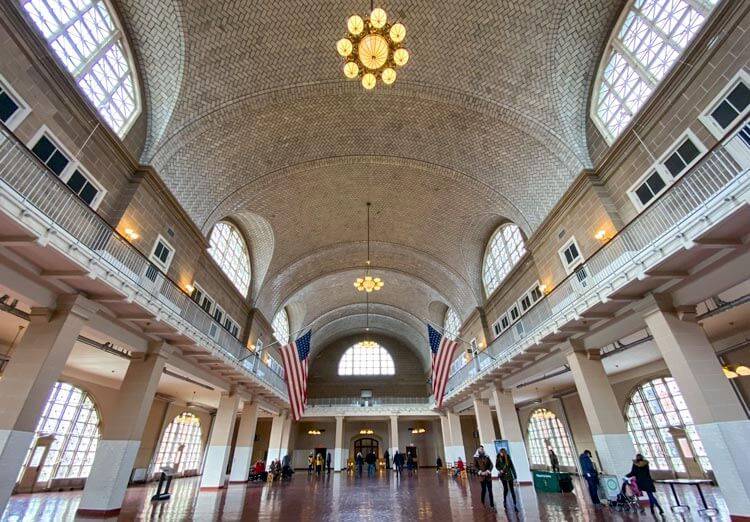
In the best case scenario, an arriving immigrant’s inspection would last from 3 – 7 hours. All inspections took place in the Registry Room, or the Ellis Island Great Hall. Doctors would scan for any obvious physical ailments, and it’s said that doctors became so adept that they could even recognize a number of diseases just by glancing at immigrants in six seconds.
The legal inspection was an interview of each immigrant. Their names had to exactly match the ship manifest and a 29-question interview they completed before boarding.
For the many that passed the medical and legal inspections, Ellis Island became the “Island of Hope”. They’d exit, and either stay in New York or go out in to the great big America beyond.
For those that didn’t, Ellis Island was the “Island of Tears”. The “Stairs of Separation” was a sad place where families were ripped apart or newfound friendships forged on the ship ended as people were sent to the hospital or, even worse, denied entry and returned to the ship for deportation.
The process of immigration through Ellis Island could take hours, days, weeks or months. A much more joyful spot is known as the “Kissing Post,” which is a post on the lower level of the Ellis Island building where families and friends who had preceded their loved ones could meet them when they were finally allowed to pass.
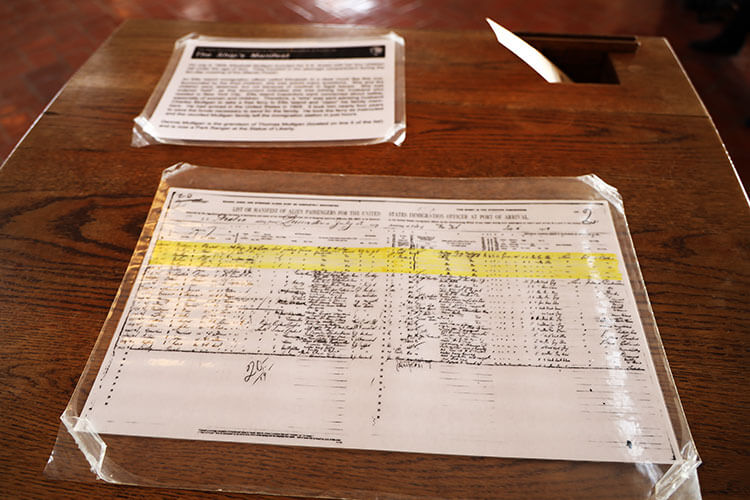
Contrary to the belief or what we’d always heard that many immigrants changed the spelling of their name once reaching America, or that US immigration officials changed the names, that’s not really what happened at all. The mangling of names actually happened overseas when recording the ships manifest. The ship manifests were handwritten by clerks who simply recorded the names phonetically, often not actually verifying the identity of the passenger or the spelling of the name.
In fact, during at least the first decade that Ellis Island served as the most popular immigration station, a third of all immigration inspectors themselves were foreign born. Mistakes either happened overseas or immigrants later changed the spellings of their own names to sound more American.
One bad joke often told on Ellis Island tours is about why so many Italian-Americans are named Tony. Said to be a bad joke born out of fact, immigrants would receive a chalk marking on them so that the 500 some employees could keep Ellis Island immigration moving like a well-oiled machine. One of those chalk markings were the letters TONY, meaning the immigrant passed and could go “to New York“. With so many nations arriving and so many languages spoken, people just took the marking to mean the guy’s name was Tony. Whether that’s true about the name Tony, we don’t know – but the chalk markings of TONY are fact.
I found this all fascinating, especially as I only recently learned that my father’s side of our family originated from Russia. My own last name was spelled as Dombrowsky when my ancestors arrived in New York, not as Dombrowski as we spell it today.
Though Ellis Island operated as an immigration station until 1954, it was in 1921 that the numbers of immigrants processed through there really began to decline. A few reasons contributed to that: the passage of the Quota Laws in 1921 and the passage of the National Origins Act in 1924.
History truly does repeat itself. Long before the advent of social media, the “old immigrants” were trying to preserve their ethnic flavor with propaganda posters discouraging new immigrant arrivals. It’s shocking to see the hate for new arrivals, particularly when those people were immigrants or children of immigrants themselves.
After 1924, Ellis Island was primarily used as a detention center. Ellis Island’s last detainee, Arne Peterssen who was a Norwegian merchant who had overstayed his welcome, was released to return to Norway on November 12, 1954. Ellis Island officially closed, and became part of the Statue of Liberty National Monument in 1965.
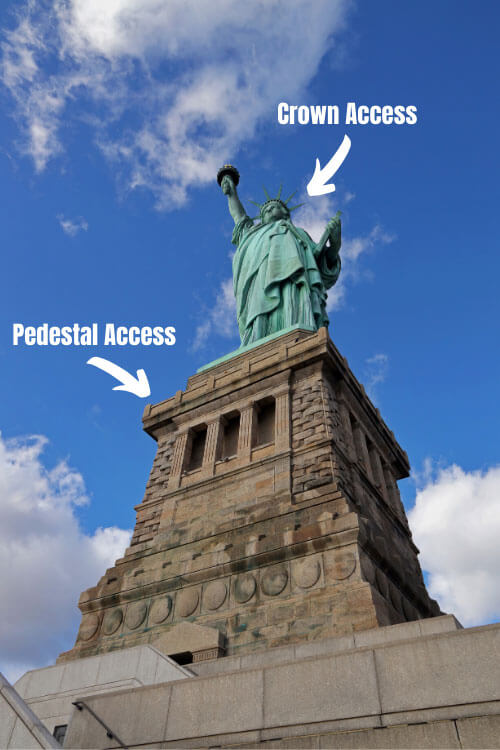
Statue of Liberty Access
Visiting the Statue of Liberty is a bit of a process. The Statue of Liberty is located on Liberty Island in New York Harbor, which is a national monument and managed by the National Park Service. While there are technically no fees for visiting Liberty Island or the Statue of Liberty, there is only one authorized ferry operator to access Liberty Island.
No matter how you visit the Statue of Liberty, every visitor goes through airport-style security screening before boarding the ferry to Liberty Island. Visitors with pedestal or crown access tickets and going inside the Statue of Liberty also go through a second security screening once on Liberty Island before entering the pedestal. Bags are not permitted, and lockers are available to store small bags on Liberty Island.
You can buy Statue of Liberty tickets directly with Statue Cruises, who are the only authorized ferry and ticket operator for the park. There are several options for how to get Statue of Liberty tickets: a reserve ticket, a pedestal reserve ticket or a crown reserve ticket.
All of the official Statue of Liberty tickets you can book directly with Statue Cruises included round trip ferry service and access to the Statue of Liberty grounds and Ellis Island. If you want to go “inside” the Statue of Liberty, there are two options: pedestal access or crown access. Tickets for both of these options are limited to a certain number of visitors per day and book up well in advance, even as far as 2-6 months in advance during peak season.
There has been no public access to the Statue of Liberty torch since 1916. It’s accessed by a very narrow 40-foot ladder and isn’t open to the public for safety reasons.
A Reserve Ticket simply means that you have a ticket and will board the ferry to Liberty Island at a specific time on a specific date. You’ll be able to visit the grounds of Liberty Island, Ellis Island and the museum there; but you will not be able to go inside of the Statue of Liberty.
A Pedestal Reserve Ticket gives you round trip ferry service at a specific time, access to visit the grounds of Liberty Island, the Statue of Liberty pedestal and Statue of Liberty Museum, and Ellis Island and the museum there.
A Crown Reserve Ticket gives you round trip ferry service at a specific time, access to visit the ground of the Liberty Island, the Statue of Liberty pedestal and Statue of Liberty Museum, the Statue of Liberty Crown (note that there is no elevator up to the crown), and Ellis Island and the Ellis Island Museum.
While an audio guide does come with all Statue Cruises ticket options, we still felt that our Walks guide really made our visit to the Statue of Liberty and Ellis Island. Rachel was so knowledgeable, really helped to navigate the entire process with security and boarding the ferry, and was essential in making sure we were in the best viewing spots.
It’s good to know that Statue Cruises is the only boat that is allowed to get close to and dock at Liberty Island. Statue of Liberty boat tours cruise around Liberty Island from a distance, and are not the best way to get a close-up look at the statue.
Know Before You Go
Otherwise, you can book the tickets on your own through Statue Cruises. Note that different types of tickets offer different access.
Where to Eat on Ellis Island
There is an Ellis Island restaurant, which is called the Ellis Island Café. There are a variety of hot and cold sandwiches available, a soup of the day, and a hot meal of the day along with chips, cookies and drinks available. The food is reasonably priced and good for concession food at a major tourist attraction.
Our Early Access Statue of Liberty Tour was in partnership with Walks in order to bring you this story. However, Luxe Adventure Traveler maintains full editorial control of the content published on this site. As always, all thoughts, opinions, and enthusiasm for travel are entirely our own. This article contains affiliate links. When you book on Walks through our affiliate partner site, we earn a small commission at no additional cost to you.


Leave a Reply